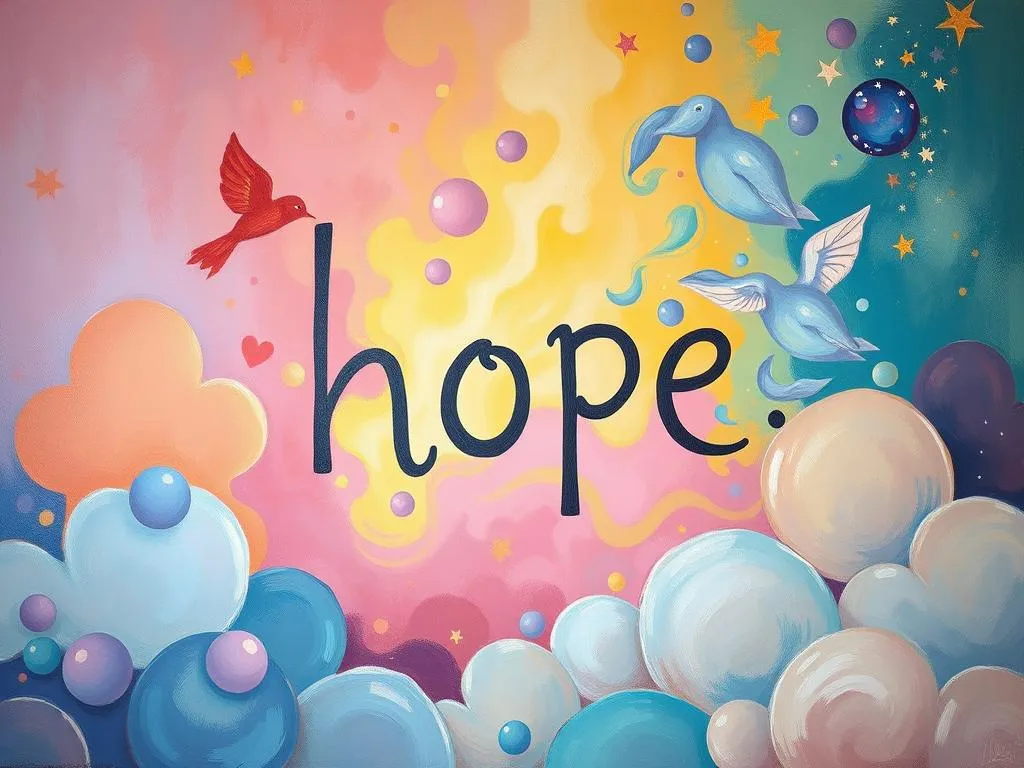
Dreams have long been a source of fascination and intrigue for humanity, serving as a window into our subconscious mind. Among the myriad themes that can emerge in our dreams, the concept of hope stands out as a powerful symbol. Hope dreams often resonate deeply with individuals, reflecting not only their aspirations but also their fears, desires, and emotional states. Understanding these dreams can provide valuable insights into our waking lives, allowing us to navigate personal challenges and cultivate a more fulfilling existence.
Symbolism and Meaning
The symbolism of hope in dreams can be multifaceted, encompassing various elements that reflect both positive and negative aspects of our psyche. At its core, hope represents the possibility of a brighter future, a longing for change, and the belief that obstacles can be overcome. When hope appears in dreams, it can take on different forms, each carrying unique implications.
One common symbol associated with hope is light. Dreaming of bright light or sunlight breaking through clouds often signifies clarity, optimism, and a sense of renewal. This illumination can represent a new understanding or insight that has emerged from a period of darkness or confusion. Conversely, if the light is dim or flickering, it may indicate uncertainty or wavering faith, suggesting that while hope exists, it may be fragile.
Another significant symbol is flight. Dreams of soaring through the air can evoke feelings of freedom, liberation, and the ability to rise above challenges. This sense of elevation often correlates with a desire to escape from current troubles or limitations. However, if the flight is turbulent or accompanied by fear, it may reflect anxiety about the future or a sense of losing control over one’s circumstances.
Water is another powerful symbol tied to hope. Dreaming of calm, clear waters can signify emotional healing and tranquility, suggesting that a period of emotional turmoil is coming to an end. On the other hand, turbulent waters might indicate that hope feels distant and that one is struggling to navigate through a storm of emotions.
The presence of nature in hope dreams can also be significant. For instance, blooming flowers or lush landscapes often represent growth and potential, suggesting that positive changes are on the horizon. Conversely, barren landscapes or wilting plants may symbolize stagnation or the fear that dreams will not come to fruition.
These symbols can be interpreted in various ways depending on the dreamer’s personal experiences and emotional state. It is essential to consider the context of the dream and the feelings it evokes for a more nuanced understanding of its meaning.
Key Scenarios and Variations
Hope dreams can manifest in numerous scenarios, each offering a different perspective on the underlying themes of aspiration and desire. For instance, one might dream of achieving a long-held goal, such as graduating from school or landing a dream job. In such cases, the dream often reflects the dreamer’s ambition and the hope that their hard work will pay off. This scenario can serve as a motivating force, encouraging the dreamer to continue pursuing their goals in waking life.
Alternatively, dreams may depict a journey or quest for something meaningful, such as searching for a lost treasure or embarking on an adventure. These narratives often symbolize the dreamer’s quest for purpose and fulfillment. A successful resolution to the journey may indicate that the dreamer is on the right path, while obstacles encountered along the way could suggest feelings of doubt or frustration.
Another variation involves dreaming about reconnecting with a loved one or experiencing a moment of reconciliation. Such dreams can symbolize healing and the restoration of hope in relationships. They may signify a desire for connection and the belief that past grievances can be resolved. However, if the dream takes a negative turn, such as losing that connection again, it may highlight fears of abandonment or unresolved issues.
Dreams of hope may also take a more surreal or abstract form, such as envisioning a utopian society or a world where dreams come true. These dreams can reflect the dreamer’s idealistic ambitions and their wish for a better reality. However, they may also serve as a reminder to confront the disparity between one’s dreams and the current state of affairs, prompting a call to action.
Ultimately, the specific scenario and its emotional impact play a crucial role in shaping the interpretation of hope dreams. Engaging with these narratives allows individuals to explore their deepest desires and fears, fostering a sense of self-awareness and clarity.
Real-Life Connections and Takeaways
Understanding hope dreams can offer valuable insights into our waking lives, encouraging us to reflect on our aspirations and the challenges we face. By connecting the themes present in these dreams to real-life situations, we can gain a deeper understanding of our emotional landscape and identify areas for growth.
One practical approach is to consider the current challenges and uncertainties in your life. If you find yourself dreaming of hope amidst adversity, it may be a sign that you possess the inner strength and resilience needed to overcome obstacles. Reflecting on the symbols present in your dream can help you identify specific areas where you feel hopeful or where you may need to cultivate more optimism.
Additionally, take note of any recurring themes or symbols in your hope dreams. These elements may provide clues about your subconscious desires and aspirations. For instance, if you frequently dream of bright light, it may signify a deep-seated longing for clarity and understanding in a particular situation. Consider how you might pursue that clarity in your waking life, whether through introspection, seeking advice, or making proactive changes.
Moreover, engaging in self-reflection after experiencing a hope dream can be incredibly beneficial. Journaling about the dream and your feelings surrounding it can help solidify your insights and clarify your goals. Write down what aspects of the dream resonated with you and how they connect to your current life circumstances. This practice can foster a sense of agency and empower you to take actionable steps toward achieving your dreams.
Lastly, remember that hope dreams can serve as reminders to cultivate a positive mindset. They can encourage you to focus on possibilities rather than limitations. Surrounding yourself with supportive individuals and engaging in activities that inspire joy and creativity can enhance your overall sense of hope and resilience.
In conclusion, hope dreams are rich in symbolism and meaning, offering profound insights into our aspirations, fears, and emotional states. By examining the various symbols and scenarios that arise in these dreams, we can better understand ourselves and our desires. Reflecting on these dreams and integrating their lessons into our waking lives can help us navigate challenges with renewed hope and purpose. As you explore your own hope dreams, allow yourself to embrace the possibilities they present and consider how you can bring those dreams to life in your daily existence.







